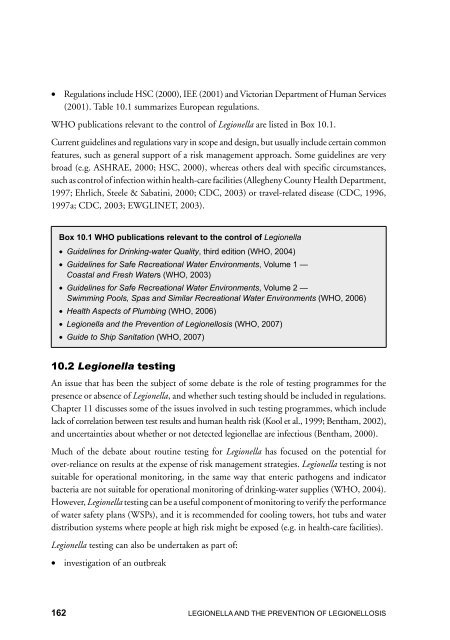LEGIONELLA - World Health Organization
LEGIONELLA - World Health Organization
LEGIONELLA - World Health Organization
Create successful ePaper yourself
Turn your PDF publications into a flip-book with our unique Google optimized e-Paper software.
• Regulations include HSC (2000), IEE (2001) and Victorian Department of Human Services<br />
(2001). Table 10.1 summarizes European regulations.<br />
WHO publications relevant to the control of Legionella are listed in Box 10.1.<br />
Current guidelines and regulations vary in scope and design, but usually include certain common<br />
features, such as general support of a risk management approach. Some guidelines are very<br />
broad (e.g. ASHRAE, 2000; HSC, 2000), whereas others deal with specific circumstances,<br />
such as control of infection within health-care facilities (Allegheny County <strong>Health</strong> Department,<br />
1997; Ehrlich, Steele & Sabatini, 2000; CDC, 2003) or travel-related disease (CDC, 1996,<br />
1997a; CDC, 2003; EWGLINET, 2003).<br />
Box 0. WHO publ cat ons relevant to the control of Legionella<br />
• Guidelines for Drinking-water Quality, third edition (WHO, 2004)<br />
• Guidelines for Safe Recreational Water Environments, Volume 1 —<br />
Coastal and Fresh Waters (WHO, 2003)<br />
• Guidelines for Safe Recreational Water Environments, Volume 2 —<br />
Swimming Pools, Spas and Similar Recreational Water Environments (WHO, 2006)<br />
• <strong>Health</strong> Aspects of Plumbing (WHO, 2006)<br />
• Legionella and the Prevention of Legionellosis (WHO, 2007)<br />
• Guide to Ship Sanitation (WHO, 2007)<br />
10.2 Legionella testing<br />
An issue that has been the subject of some debate is the role of testing programmes for the<br />
presence or absence of Legionella, and whether such testing should be included in regulations.<br />
Chapter 11 discusses some of the issues involved in such testing programmes, which include<br />
lack of correlation between test results and human health risk (Kool et al., 1999; Bentham, 2002),<br />
and uncertainties about whether or not detected legionellae are infectious (Bentham, 2000).<br />
Much of the debate about routine testing for Legionella has focused on the potential for<br />
over-reliance on results at the expense of risk management strategies. Legionella testing is not<br />
suitable for operational monitoring, in the same way that enteric pathogens and indicator<br />
bacteria are not suitable for operational monitoring of drinking-water supplies (WHO, 2004).<br />
However, Legionella testing can be a useful component of monitoring to verify the performance<br />
of water safety plans (WSPs), and it is recommended for cooling towers, hot tubs and water<br />
distribution systems where people at high risk might be exposed (e.g. in health-care facilities).<br />
Legionella testing can also be undertaken as part of:<br />
• investigation of an outbreak<br />
<strong>LEGIONELLA</strong> AND THE PREVENTION OF LEGIONELLOSIS

















